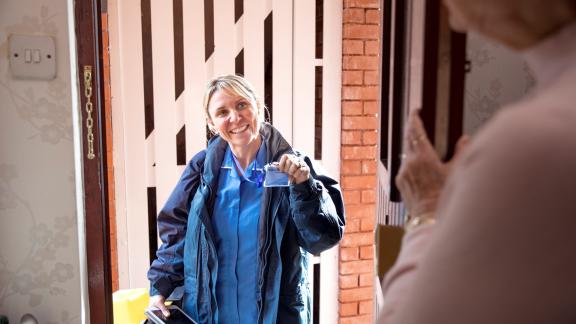Delivering more joined-up care for local communities

This briefing from the Community Network, hosted by the NHS Confederation and NHS Providers, highlights how community providers are well placed to provide more integrated care with partners across the health and care system, to deliver more person-centred care in the community.
Background
Earlier this year, the House of Lords committee on the integration of primary and community care published a call for evidence, inviting views on how primary and community services are working together to deliver more integrated care. The aim of the inquiry was to explore and consider the challenges facing the sector and any barriers preventing further integration.
In response to this, the Community Network submitted written evidence on behalf of members, reflecting some of the key barriers and enablers to integration. Siobhan Melia, chair of the Community Network, also gave oral evidence in June 2023, highlighting how integration between primary care and community providers can support admission avoidance and reduce delayed discharge.
This briefing draws together the key points from our submission and builds on it by highlighting two case studies of good practice where community providers are working innovatively to overcome the barriers to integration.
Introduction
Community provider leaders are optimistic about the potential for greater integration across primary and community services, particularly though integrated neighbourhood teams. At a local level, many are already working closely with primary care colleagues to deliver more integrated care in the community, as per the Fuller stocktake recommendations. This is helping to reduce duplication, improve patient experiences and provide more opportunities for staff to work and train in different care settings.
Despite the sustained and severe pressures facing the whole health and care system, progress is being made on these ambitions for greater integration. For example, Leeds Community Healthcare NHS Trust has developed neighbourhood teams to act as a hub for service integration, while Central London Community Healthcare NHS Foundation trust has implemented a joint case management service between primary care and community services.
As part of our work in this area, we have spoken to a number of community providers to understand and share how they are working with primary care colleagues to deliver more joined-up care for local communities.
Case study - North Tees and Hartlepool NHS Foundation Trust
North Tees and Hartlepool NHS Foundation Trust has been working with colleagues from primary, secondary and social care to ensure patients are only admitted to hospital when it is right for them. The trust has a well-established multi-disciplinary ‘home first’ team, which has improved the trust’s capacity to care for patients in their own home. The team is made up of community and other healthcare staff, as well as local authority colleagues and the Hartlepool and Stockton Health GP federation. Having this multi-disciplinary service ensures patients are being treated at the right time in the right place and by the right professional, minimising the risk of duplication and freeing up time for more senior staff to make best use of their expertise.
Case study - Bromley Healthcare
Seven years ago, Bromley Healthcare, a community interest company providing healthcare services across Bromley, Bexley, Greenwich and Lewisham, switched to EMIS software to align their system with primary care. The aim was to create a joined-up view of the primary and community support an individual was receiving at any one time, and the costs associated with delivering these services. Since then, Bromley Healthcare has implemented a full data-sharing agreement with 42 GPs across Bromley, which allows for a cross-organisational understanding of the care people are receiving in the community.
Underlying barriers
Although community providers are ambitious about greater integration and understand the benefits for patients, staff and system flow, there remain a number of underlying barriers we need to overcome to accelerate progress towards more joined-up services.
1. Workforce shortages
Key ask
Delivery of the NHS Long Term Workforce Plan, including greater national prioritisation and investment in growing and developing the workforce in community health services and primary care.
The supply of community staff has not kept pace with increased demand for services and strategic ambitions to boost out-of-hospital care. There are staff shortages across key community roles such as district nursing, podiatry, and speech and language therapy, many of which will play a central role in multi-disciplinary teams. This trend is replicated in the primary care sector where there were 2,164 fewer full-time equivalent (FTE) GPs in May 2023 compared to September 2015 (29,364 down to 27,200), while demand for GP appointments continues to grow. Community provider leaders are clear that without the right numbers and skills mix of community and primary care staff, there is limited capacity to take forward strategic goals around integration and scale up the important work being undertaken by multi-disciplinary teams.
Support is also needed to maximise the potential benefits that could be offered by the additional roles reimbursement (ARRS) scheme. While it is working well in some places, there are some challenges with implementing the scheme, particularly in relation to pay and terms and conditions, where the sectors do not always align.
Greater national prioritisation and investment in community health services and primary care is needed to support recruitment and retention; developing new roles and alternative training routes; ensuring medical and nursing degrees offer placements in community settings; and offering more flexible career pathways for staff to move into and across the sectors. It will also promote resilience across the workforce, developing staff skills to work across different settings and helping to educate the workforce as a whole about the benefits of community-based provision and the level of risk that can be managed in the home or a community setting, with multi-disciplinary teams more likely to deliver more person-centred, wraparound care for individuals.
The recently published NHS Long Term Workforce Plan is a significant moment in supporting the ambitions for greater integration between community and primary care. The commitment to grow the proportion of mental health, primary and community staff to deliver more preventative and proactive care across the NHS is significant, as is the focus on optimising multi-disciplinary teams and the development of an integrated community and primary career framework. However, this must be accompanied by a robust implementation plan and appropriate funding to break down the barriers to recruiting and retaining staff in the sector.
2. Digital and data
Key ask
Further national support to improve data on community health services and enable interoperability between partners.
There are specific complexities related to collecting national data in the community sector. Although there is national work underway to develop a national dataset for community services, the complexity and variability in size and scale of providers within the community sector means this is challenging. Data quality can be variable, and the NHS England community services dataset does not currently produce real-time data that providers can easily use to benchmark and improve their performance. This can make it difficult for community providers to develop a robust business case to secure government and national funding for investment in integration.
Problems with sharing data between community and primary care can also make it very difficult to develop a holistic view of a person’s health and care needs, therefore making it challenging to deliver integrated care through multi-disciplinary teams. This can lead to duplication and increased clinical risk for patients. Community providers report instances where a lack of shared data leads to patients being referred into an urgent and emergency care pathway when they would be better supported at home with an urgent community response team and wider wraparound care.
Local work to navigate some of these challenges, including through greater alignment supported by integrated care systems and the development of local information governance agreements, is important. However, scaling this up requires greater national investment in and prioritisation of community data and digital capacity, to better understand service delivery and the impact of further integration.
National-level support to promote interoperability, or data sharing, between IT systems, is also key. Interoperability between system partners is central to developing a shared understanding of the care needs of a local population. In turn this can support greater integration between community and primary care.
3. Capital investment
Key ask
Greater access to capital funding for the community and primary care sectors, both nationally and through appropriate consideration in ICB capital planning processes.
In the last decade, access to capital funding has been very limited for all providers. Amid cuts to public spending, the NHS capital budget was raided between 2014/15 and 2018/19 to support day-to-day revenue spending. While 2021 saw an increase in the capital budget with a multi-year capital funding settlement, the process to access capital has often been very competitive, and the majority of recent investment has been targeted at the acute sector. This includes through the government’s new hospital programme.
However, investment in community estates is essential to delivering on strategic ambitions to deliver more care in the community, including through greater integration with primary care. Working across organisations in multi-disciplinary teams is often supported by co-location in a physical space, and capital funding for community providers is therefore important in providing an environment that enables collaborative working across sectors.
This is increasingly important given the pressures being felt across the health and care system, especially on urgent and emergency care pathways and in delayed discharges. Further investment in capital estates in the community can also enable the development of modern facilities to deliver integrated care, focused on rehabilitation, reablement and intermediate services. These services play a vital role in keeping people well in the community, including through admission avoidance, and can therefore alleviate pressure in other parts of the health and care system.
Ensuring high-quality integrated care at local level also requires clear ownership models and routes for funding to support community providers and primary care providers to collaborate more effectively on use of estates. At present, community providers often face challenges investing in premises that are jointly run with primary care partners or accommodation rented from other partners. This complexity is amplified by the fact that many community services will operate on multiple, often smaller, sites based in community locations. For example, if a community provider wants to re-develop a premises that is leased from NHS Property Services but shared with a GP practice, the routes for funding and approval are much more complex than if they were investing in their own buildings, which in turn disincentivises more integrated working across the two sectors. Community providers also tell us that ownership models often mean delays in fixing operational issues day to day. For example, ensuring Wi-Fi access and temperate conditions for patients and staff.
Patricia Hewitt’s review into integrated care systems recommended a review into the NHS capital regime, which the government has now accepted, saying it would confirm next steps shortly. We would encourage the review to consider the wider capital funding picture and explore how greater access for community providers (and other sectors like mental health) can support wider strategic ambitions for the health and care system.
Conclusion
Community providers are well placed to deliver more integrated care with partners across the health and care system. They have demonstrated their role in working with acute hospitals to establish virtual wards; with ambulance trusts to prevent unavoidable hospital admissions and urgent community response services; and with primary care partners to deliver more person-centred care in the community.
And while there is still a long way to go to fully realise the benefits of integration, at a local level, community providers are optimistic about the opportunities presented by working with primary care colleagues. Many have already established integrated neighbourhood teams to deliver more localised care. Community provider leaders continue to express optimism and enthusiasm about the opportunities around neighbourhood teams and the medium-to-long-term ambitions for integrated care.
In order to meaningfully achieve the ambitions of greater integration between primary care and community providers, the sector would benefit from ensuring the potential opportunities of community provision for patients are consistently articulated in national NHS and care policies. The sector also requires appropriate access to national investment, prioritisation and time. This will allow providers to scale up initiatives and improve care for patients in a meaningful and sustainable way.




